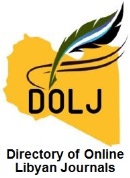دراسة القيمة الغذائية ونسب بعض المعادن لأربيان الأجاج Artemia salina L., 1758 بسبخة أبي كماش، ليبيا
DOI:
https://doi.org/10.59743/jmset.v4i2.80الكلمات المفتاحية:
الأرتيميا، أربيان الأجاج، القيمة الغذائية، أبي كماش، تغذية الأسماكالملخص
نظراً لقلة الدراسات البيئية حول السُبخ والبحيرات المالحة بليبيا، لذا أجريت هذه الدراسة على سبخة أبي كماش خلال فصلي الشتاء والربيع لسنة 2006م لاحتوائها على كثافة عالية من الأرتيميا. جُمعت حويصلات الأرتيميا من الماء وأطراف السبخة، وأخذت قياسات أقطارها الخارجية والداخلية ودُرست خصائص فقسها؛ كما قُدرت القيمة الغذائية للحويصلات واليرقات في الطور الأول والأطوار البالغة. أظهرت النتائج تذبذباً في قياس أقطار الحويصلات غير المنزوعة والمنزوعة القشرة، حيث كانت أقطار الحويصلات غير المنزوعة أكبر بقليل في فصل الربيع منها في الشتاء والعكس صحيح لأقطار الحويصلات منزوعة القشرة؛ وكان سمك القشرة حوالي الضعف في فصل الربيع (12.39 ميكرون) منه في الشتاء (6.78 ميكرون). كما كانت نسبة الفقس متقاربة خلال 24 ساعة الأولى ثم اختلفت خلال 48 و 72 ساعة التالية من زمن التجربة؛ وكانت نسبة وكفاءة الفقس عموماً أعلى في فصل الربيع منها في الشتاء. وبينت دراسة القيمة الغذائية للأفراد البالغة، أن نسبة البروتين في أجسامها تفوق باقي المكونات الأخرى (العضوية وغير العضوية)، وكانت نسبته في اليرقات أعلى منها في الحويصلات والأفراد البالغة. كما قلت مستويات الدهن في الأرتيميا (الحويصلات والأطوار اليرقية والأفراد البالغة)؛ غير أن هذه المشكلة يمكن تفاديها باستخدام تقنية التخصيب (Enrichment) أثناء استخدام الأرتيميا في الزراعة المائية. وكان تركيز عنصر الحديد أعلى من تركيز عنصر النحاس، مما يدل على أن الصبغة التنفسية للأرتيميا هي الهيموجلوبين وليست الهيموسيانين. بينما كان تركيز عنصر الماغنيسيوم في الأفراد البالغة أعلى من الأطوار الأخرى ويرجع ذلك لوسط معيشتها.
التنزيلات
المراجع
قائمة المراجع باللغة العربية
برانية، أ. ع؛ عيسى، م. أ؛ الجمل، ع. ع؛ عثمان، م. ف. م وصادق، ش. ش. (1996). الأسس العلمية والعملية لتفريخ ورعاية الأسماك والقشريات في الوطن العربي. الدار العربية للنشر والتوزيع. الجزء الثاني: 456 ص ص .
قائمة المراجع باللغة الإنجليزية
Abuissa A.A. (2000). Distribution of some Heavy Metals in Selected Components of A coral Reef Ecosystem at Cape Rachado. M.Phil University of Malaya, Malaysia.
Ballaer E.V., Vwrsichele D., Vanhaeck P., Leger P., Ben Addelkader N., Turki S., and Sorgeloos P. (1987). Characterization of Artemia from Different Localities in Tunisia with Regard to Their Use in Local Aquaculture. Artemia Research and Applications. Universa Press, Belgium.
Domingues P.M., Turk P.E., and Lee P.G. (2001). Effects of enriched Artemia nauplii on production. survival and growth of mysid shrimp Mysidopsis almyra bowman 1964 (Crustacea: Mysidacea). Aquaculture Research. Blackwell Science. Scotland, 32: 599-603.
Hadoud D., Magsodi M., Degdeg Z., and Abdulbare R. (2006). Artemia excistance in some Salt lakes that distrebued in the east costal–Libya. Bulletin de 1 INSTM. N Special 11: Actes des 8 emes Journees des Sciences de la Mer (Hammamet),129-135
International Organization for Standardization (ISO) (1871). Agricultural food products- general directions for the determination of nitrogen by the kjeldahl method (led) 1975 Switzeoland.
ISO 712. (1998). Cereals and Cereal Products- Determination of Moisture Content- Routine Reference Method, 3rd ed., Switzerland.
ISO (1993). Cereals and Milled Cereal Products- Determination of Total Ash. 3rd, Switzeoland.
Joslyn M.A. (1970). Methods in Food Analysis. Pht.Che and Srum Method of Analysis. 2nd ed., New York.
Lavens P., and Sorgeloos P. (1987). The cryptobiotic state of Artemia cysts, its diapause deactivation and hatching: a review. Artemia research and its applications, 3: 27-63.
Lavens P., and Sorgeloos P. (1991). Production of Artemia in Culture Tanks In: Artemia Biology. Browne R.A, Sorgeloos P., and Trekman C.N.A (Eds). CRC Press. MC. Florida, USA.
Lavens P., and Sorgeloos P. (1996). Manual on the Production and Use of Live Food for Aquaculture. FAO Fisheries Technical Paper. Italy.
Leger P., Bengtson D.A., Simpson K.L., and Sorgeloos P. (1986). The use and nutritional value of Artemia as a food source. Oceanogr. Mar. Biol. Ann. Rev., (24): 521- 623.
Lim C., and Persyn A. (1989). Practical feeding Penaeid shrimps. In: Nutrition and Feeding of Fish, Lovell T. (editor). New York: Van Norstrand Reinhold: 205-222.
Raineri M. (1987). Histochemical and Biochemical of Alkaline Phosphatase (ALP) Activity in Developing Embryos and Larval of Artemia. Wetteren, Belgium.
Simpson K.L. (1987). Workshop report: The Use of Artemia as Food in Aquaculture. Artemia Research and it׳s Applications ecology, culturing, Use in Aquaculture. Sorgeloos P., Bengtson D., Decleirg W., and Jaspers E. (Eds). Universa Press, Wetteren. Belgium.
Sorgeloos P., Baeza M., Benijts F., and Persoone G. (1976). Current research on the culturing of the brine shrimp Artemia salina L. at The State University of Ghent. Belgium. In: Proc 10th Europ. Symp. Mar. Biol. (1). Research in mariculture. Persoone G., and Jaspers E. (Eds). Universa Press. Wetteren, Belgium.
Sorgeloos P., Lavens P., Leger P., Tackaert W., and Versichele D. (1986). Manual for the Culture and Use of Brine Shrimp Artemia in Aquaculture. Artemia reference center. State University of Ghent, Belgium.
Wantanabe T., Ohta M., Kitajima C., and Fujita S. (1982). Important of dietary value of brine shrimp Artemia salina for fish larvae by feeding them on w3 highly unsaturated fatty acids. Bulletin of the Lapanese Society of Japanese Fisheries, 48 (12): 1775-1782.
Webster C., and Lovell R. (1990). Comparison of living brine shrimp nauplii and non living diets as first food for striped bass larvae. The Progressive Fish- Cultureist, 52: 171-175.
التنزيلات
منشور
إصدار
القسم
الرخصة
الحقوق الفكرية (c) 2018 مجلة علوم البحار والتقنيات البيئية

هذا العمل مرخص بموجب Creative Commons Attribution 4.0 International License.












